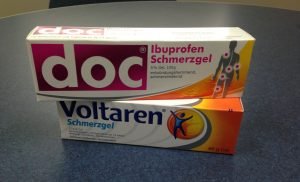Q: I’ve taken Aleve® for years for a bad knee, but now my stomach burns whenever I take it. Ibuprofen doesn’t work as well. My doctor gave me a prescription for Celebrex® which didn’t cause burning but only helped a little bit. Icy-Hot® didn’t help and capsaicin cream burns like fire. Are there any other creams out there to help joint pain?
In other countries, gel or creams containing medicines like ibuprofen have been available for years. Ibuprofen, also called Motrin®, is related to Aleve® (naproxen), and Celebrex® (celecoxib). These medicines are called NSAIDs, which stands for Non-Steroidal Anti-inflammatory Agents.
NSAIDs treat the swelling and pain of muscles or joints from either sudden injuries like a muscle sprain or strain, or chronic inflammation such as the joint swelling of arthritis. In the United States most people take NSAIDs as tablets, but both tablet and topical (gel, cream, ointment or spray) versions have been used for decades in the UK and Europe.
The advantage to using an NSAID cream or gel over a tablet is that relief goes directly to your painful areas without the side effects that NSAIDs can often cause, like stomach pain, kidney or heart problems. For people who take a blood thinner, using a topical form of NSAID avoids the risk of bleeding.
You’re not the only one who has side effects from an NSAID medicine. Americans with ulcers, kidney or heart problems would benefit from having safer forms of NSAIDs, but the only topical NSAID currently available is diclofenac, and it requires a prescription.
I believe pharmaceutical companies haven’t marketed any topical versions of their NSAIDs in the U.S. because there’s not enough patent protection to make it profitable. Ibuprofen and naproxen became available as non-prescription (OTC) tablets only after the U.S. patents for their prescription forms expired.
Another roadblock to making topical forms of NSAIDs available is whether it can penetrate the skin. Grinding up a medicine into powder and adding it to a cream or ointment doesn’t guarantee that it’s going to work; a drug company may decide that the topical version of their NSAID isn’t effective enough to justify the investment needed to pursue approval from the FDA.
Topical NSAIDs are used to ease the acute pain of sprains and strains as well as the chronic pain of osteoarthritis. A study called Topical NSAIDs for acute pain: a meta-analysis published in 2004 looked at many different studies of various NSAIDS, with successful treatment being able to decrease pain at least 50% within 1 week. This analysis found ketoprofen gel best at relieving acute pain with ibuprofen gel a distant second. Full details are available at http://www.biomedcentral.com/1471-2296/5/10.
In September 2012 the Cochran Institute published the meta-analysis Topical NSAIDs for chronic musculoskeletal pain in adults. It collected various studies; many of them unpublished work from the files of drug companies. Two NSAIDs stood out as effective in chronic musculoskeletal pain: diclofenac and ibuprofen, with diclofenac being just as effective topically as in a pill form, yet with minimal side effects. Both ibuprofen and diclofenac gel are available without a prescription in the UK and Europe.
Last week while visiting my daughter Maureen in Germany, I saw Voltaren® gel advertised in the window of several German pharmacies. The day before we left to go home I walked into a German pharmacy, called an Apothek to buy some. Pointing at the boxes of gel displayed in their window, I rubbed my arm, saying, “Voltaren®, bitte?” With Maureen translating, I discovered that ibuprofen gel had been available for over 10 years and was now generic, Voltaren® gel was the more popular of the two gels, and both were for sale without a prescription. I walked out of the Apothek triumphantly clutching a tube of each, even though all the directions were in German!

Topical diclofenac is available in the U.S., by prescription only, as: Voltaren® 1% gel applied 4 times daily; Pennsaid® 1.5% solution applied 3-4 times daily; Pennsaid® 2% solution in a pump applied twice daily; and Flector® 1.3% patch applied twice daily. Diclofenac is also available as Solaraze® 3% gel for rosacea.
Check with your doctor to see if one of these would be helpful for you; because they are brand name products, there should be samples you can try.

